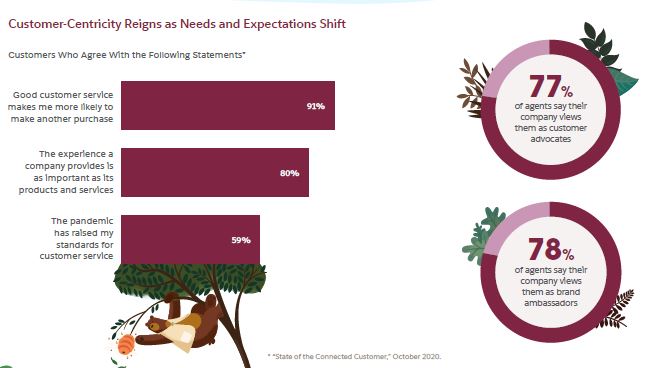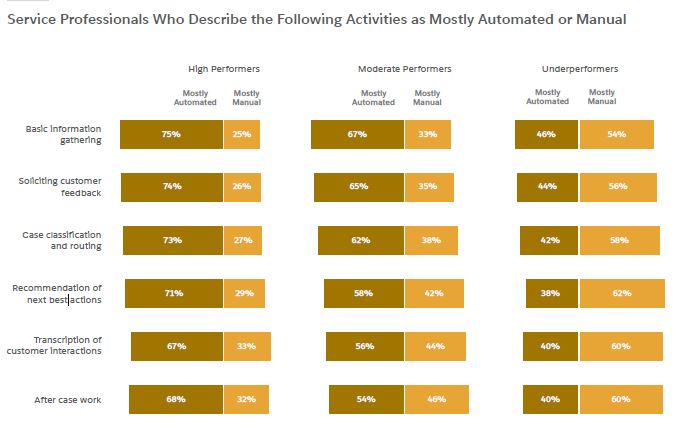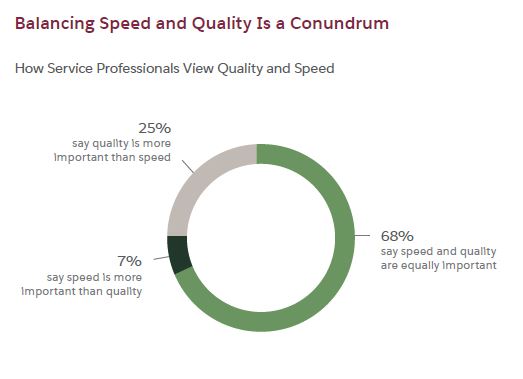Salesforce.com just released its latest “State of Service” report with insights into how 7,000+ service professionals are adapting during the pandemic.
I’d like to highlight a few key findings with the help of customer service thought leaders.
Let’s start with the critical role of customer service in customer loyalty. A previous Salesforce.com study found that 9 of 10 customers agree that “good” customer service increases their likelihood to purchase, and 8 of 10 think that “experiences” are as important as a company’s products and services. Furthermore, the pandemic has raised standards for 6 of 10 customers. From that same study, nearly 8 of 10 agents say the company views them as customer or brand advocates.

Turning to the recent State of Service report, the main conclusion is that customer service has changed because the pandemic has driven customers to digital channels… and many companies were not ready. For example:
- Roughly 9 of 10 service pros say that the pandemic has exposed technology or service gaps for digital engagement
- As a result, 81% of customer service leaders are accelerating digital transformation, including the use of AI and chatbots
- The shift to Work From Home (WFM) has gone pretty well overall, but training and onboarding is a concern for most
I asked customer service experts to comment on a finding they found especially significant.
Metrics Reveal Priorities
Chip Bell, author of numerous books including Inside Your Customer’s Imagination, sees evidence that better-performing organizations use metrics that show they value customers and employees.
When you examine how organizations view “the most important service performance indicators,” you are reminded of how beliefs about the customer impact success. High performing organizations ranked “customer sat, customer effort, customer retention, and customer life-time value” as their top four indicators; low performing organizations ranked “revenue, customer sat, average handle time, and service level agreement performance” as their top four indicators. One belief system looks outward toward the customer (what customers are feeling); one looks inward toward the organization (what we are doing). Beliefs shape leader actions, organization practices, and ultimately success.

Automation vs. Manual
Bill Price of Driva Solutions, an expert in large/complex contact centers and analytics, is encouraged with the growth in automated next best actions.
A few years ago sharing or alerting customers to “next best actions” (NBA) after the current interaction was rare, and yet in 2020 automating NBA — especially for “High performers” — is exciting. To offer NBA companies need to link customer histories, customer journeys, and needs with revenue-producing and expense-controlling actions using Big Data and AI, and to automate NBA requires even more sophistication. As with all new initiatives, “the proof is in the pudding” meaning that companies also need to track the downstream results offering NBA, whether via automation or verbally, and increase the accuracy of NBA.

Quality vs. Speed
Jeremy Watkin, a 20-year contact center veteran currently serving as Director of Customer Support and CX at NumberBarn, has thoughts about balancing service quality and speed, a concern for 63% of agents.
It’s encouraging to me to see that essentially 93% of service professionals believe that quality is either as or more important than speed. This shows me that leaders are finally balancing out their metrics and not strictly managing to AHT (Average Handle Time). But don’t be fooled into thinking that just because service professionals believe quality is important that they actually understand what quality means. Leaders must define quality, set a standard, train their teams on that standard, and reinforce it with regular quality management.

Revenue Growing Rapidly as Service KPI
And finally, savvy CRM tech analyst Thomas Wieberneit of aheadCRM/Epikonic found interesting the shift of revenue into a more important KPI for service organizations. The report found that 71% of service professionals say they’ve changed or reprioritized metrics due to the pandemic.
While this is not necessarily company revenue but service organization generated revenue, it shows that companies are looking more at tying CX initiatives to monetary goals (cost down, revenue up). I think that this will strengthen the trend towards automated systems like the use of conversational AI. And, more mundanely, we will see more and more computer telephony, as this also helps in getting more precise customer interaction and behavioural data, and hence the basis for improvements in interaction quality.

You can get more info and download the full report here (registration required).



